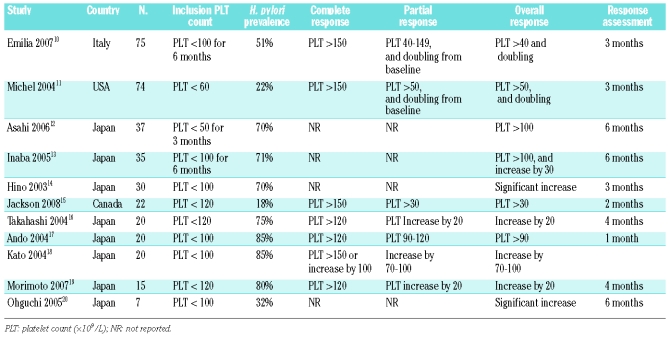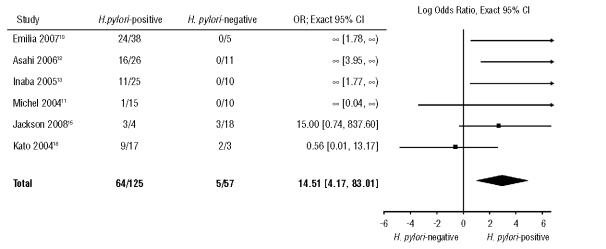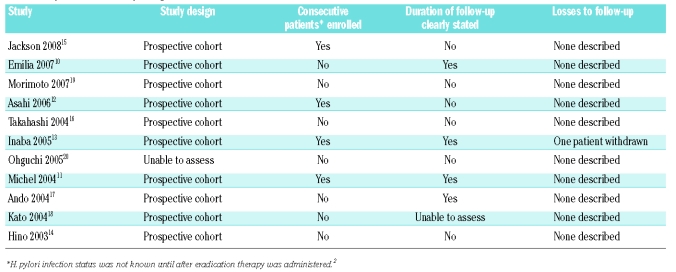Abstract
Eradication of H. pylori improves thrombocytopenia in some patients with immune thrombocytopenic purpura by mechanisms that remain obscure. Platelet count responses may occur independently of H. pylori infection as a result of the immune modulating effects of macrolide antimicrobials or the removal of other commensal bacteria. We performed a systematic review of the literature to determine the effect of H. pylori eradication therapy in patients with immune thrombocytopenic purpura by comparing the platelet response in patients who were, and who were not infected with H. pylori. MEDLINE, EMBASE, Cochrane central registry and abstracts from the American Society of Hematology (from 2003) were searched in duplicate and independently without language or age restrictions. Eleven studies, 8 from Japan, were included enrolling 282 patients with immune thrombocytopenic purpura who received eradication therapy; 205 were H. pylori-positive and 77 were H. pylori-negative. The odds of achieving a platelet count response following eradication therapy were 14.5 higher (95% confidence interval 4.2 to 83.0) in patients with H. pylori infection (51.2% vs. 8.8%). No study reported bleeding or quality of life. Adverse events were reported in 12 patients. H. pylori eradication therapy was of little benefit for H. pylori-negative patients. These findings strengthen the causal association between H. pylori infection and immune thrombocytopenia in some patients. Randomized trials are needed to determine the applicability of H. pylori eradication therapy across diverse geographical regions.
Keywords: helicobacter, autoimmunity, purpura, platelets
Introduction
A causal link between H. pylori infection and immune thrombocytopenic purpura (ITP) is suggested by clinical studies demonstrating a platelet count response in approximately 50% of patients following H. pylori eradication.1–3 However, eradication therapy may result in the improvement of thrombocytopenia by mechanisms independent of H. pylori including the immune modulating effects of the treatment itself4 or the removal of other commensal bacteria. In support of these hypotheses is a recent meta-analysis showing an increase in platelet count following treatment in some patients with ITP regardless of the outcome of eradication therapy.2 Furthermore, in certain geographical regions, the prevalence of H. pylori infection among patients with ITP is no different than the general population5 suggesting that the association between H. pylori and ITP is not certain. Understanding the mechanism of the platelet count response following H. pylori treatment may help explain pathophysiology and determine whether or not uninfected patients stand to benefit from treatment. To determine the independent effect of H. pylori eradication therapy on platelet count response, we performed a systematic review of all studies reporting treatment responses compared to H. pylori-negative controls.
Design and Methods
Literature Search
The electronic databases of MEDLINE, EMBASE and the Cochrane central registry were searched in duplicate and independently using the subject headings Purpura, Thrombocytopenic, Idiopathic, Purpura, Thrombocytopenic, and the keywords idiopathic thrombocytopenic purpura, thrombocytopenic purpura, immune thrombocytopenia, and ITP, combined with the subject headings Helicobacter pylori, Helicobacter Infections and the keywords Helicobacter pylori, helicobacter infections and H. pylori. Abstracts from the American Society of Hematology (2003 to 2007) were searched in duplicate electronically using the term pylori. Experts were canvassed for additional references and relevant bibliographies were searched by hand. No age or language restrictions were applied. Articles were included if they enrolled patients with ITP and described the platelet count response following H. pylori eradication for both infected and uninfected patients. Eradication therapy had to include at least one antibiotic and a proton pump inhibitor. Studies that selected only H. pylori -positive patients and case reports of fewer than 5 patients were excluded.
Study quality
The quality of included studies was assessed independently by two reviewers with expertise in methodology. Reviewers assessed each study for the presence or absence of 4 key design features derived from the specifications for reporting meta-analyses of observational studies6 and from a quality assessment tool for non-randomized studies7: (i) prospective data collection; (ii) enrolment of consecutive patients unselected for H. pylori infection status; (iii) a clearly stated duration of follow-up; and (iv) a description of losses to follow-up. Disagreements were resolved by consensus. Funnel plots relating sample size to treatment effect expressed as the log of the odds ratio (OR) were examined for evidence of publication bias.
Analysis
Platelet count response, bleeding and quality of life were captured. We used two definitions of overall response – the definitions from primary reports (which varied) and a standardized definition of a platelet count rise to at least 30×109/L within six months (reported in most studies). Group level proportions for overall, partial and complete response following eradication therapy were derived for H. pylori-positive, eradicated, non-eradicated and negative patients. Age, duration of ITP, time to response and duration of response were derived by weighted means adjusted for sample size; when means and standard deviations were not reported for these variables, they were imputed from quartiles assuming a normal distribution. The comparison of proportion of responders between the H. pylori-positive and negative groups was performed using an exact test (two-tailed) for stratified data,8 and the common OR was reported with exact 95% confidence intervals (CI) to account for small sample sizes. Unweighted chance-corrected kappa was used to assess agreement between reviewers for study selection.9 This systematic review had no external source of funding. The authors had complete access to all study data, and all have seen and approved this manuscript.
Results
Article selection
The initial literature search yielded 266 citations. Titles were screened for relevance and duplicates leaving 165 citations. Of those, 76 did not meet eligibility criteria leaving 90 articles which underwent detailed review. Finally, 11 articles were included (Figure 1). Agreement on article selection was moderate (k=0.48) and discrepancies, which were often due to uncertainty about the inclusion of H. pylori-negative patients, were resolved by consensus.
Figure 1.
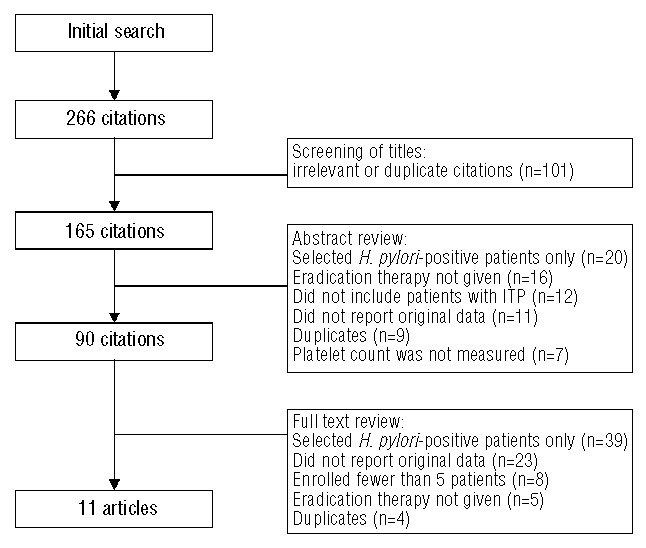
Results of study search and selection.
Study characteristics
Of 11 studies, 8 were from Japan and one was from each of Italy, USA and Canada (Table 1). Median prevalence of H. pylori infection from studies from Japan was 73% (first, third quartile 70%, 81%) compared with 22%11 and 18%15 as reported in the 2 studies from North America, and 51%10 in the study from Italy. Most studies defined ITP as thrombocytopenia in the absence of any other cause and consistent with the American Society of Hematology guidelines;21 8 of 11 studies required a bone marrow examination showing normal or increased megakaryocytes. The platelet count values for inclusion were heterogenous from study to study, ranging from ≤50×109/L12 to ≤120×109/L,11,16,19 and with an overall mean (± SD) baseline platelet count of 43±28×109/L. The definitions of platelet count responses were variable.
Table 1.
Characteristics of H. pylori eradication studies that met inclusion criteria (n=355 patients) and the criteria used to define platelet count responses.
Patient characteristics
In total, 355 patients with ITP (68.2% female) with a mean age of 51.6±17.1 years were enrolled. None were children. Mean prior duration of ITP was 61.5 months and 47 (13.2%) patients had undergone splenectomy. Mean duration of follow-up was 34.5±23.9 months. Of 355 patients, 282 received eradication therapy as part of the study design; 205 (72.7%) were H. pylori-positive and 77 (27.3%) were H. pylori-negative. H. pylori was successfully eradicated in 166 (81.0%) infected patients (Figure 2).
Figure 2.
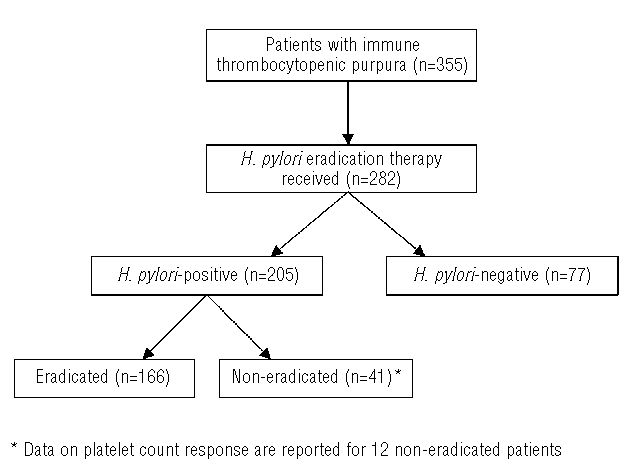
Patients who received H. pylori eradication therapy.
H. pylori diagnosis and treatment
The urea breath test was used to diagnose H. pylori in all studies except one15 in which fecal antigen testing was used. Additional tests for H. pylori included serology (n=5 studies) and tissue culture (n=1). Treatment consisted of amoxicillin 750 to 1500 mg twice daily, clarithromycin 200 to 400 mg twice daily, and a proton pump inhibitor for seven days in all studies except one11 in which the duration of therapy was 14 days.
Response
The overall platelet count response (as variably defined in primary reports) for H. pylori-positive (n=205), eradicated (n=166) and negative (n=77) patients was 53.1%, 53.6% and 6.5% respectively (Table 2). The OR (OR; positive vs. negative) was 24.0, exact 95% CI 7.1 to 125.1. Using the homogeneous definition of a platelet count increase to 30×109/L or higher by six months,10–13,15,18 overall platelet count response was 51.2%, 52.5% and 8.8% for positive (n=125), eradicated (n=115) and negative (n=57), respectively; OR (positive vs. negative) 14.5, 95% CI 4.2 to 83.0 (Figure 3). Complete platelet count response (platelet count greater than 150×109/L) was not significantly different between H. pylori-positive and negative patients (OR 3.4, 95% CI 0.7 to 22.4), although only 4 studies reported this outcome. A comparison of partial response was not possible since the definition varied too widely between studies. Relapses were reported in 3 H. pylori-positive responders, and one H. pylori-negative responder.
Table 2.
Platelet count responses among patients with immune thrombocytopenic purpura given H. pylori eradication therapy.
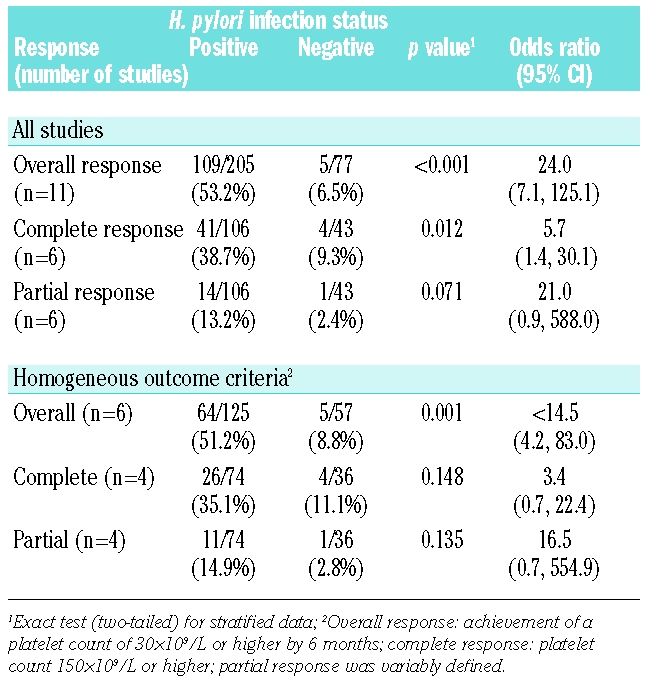
Figure 3.
Pooled odds ratio (OR) of H. pylori eradication therapy on overall platelet count response (platelet count greater than 30x109/L by 6 months) in H. pylori-positive and H. pylori-negative patients with immune thrombocytopenic purpura.
We performed a descriptive sensitivity analysis using only those studies that enrolled consecutive patients whose infection status was not known until after the effect of treatment had been assessed (n=4 studies). Three of those studies, one from Canada15 and 2 from Japan,12,13 showed a positive effect of treatment in infected compared with uninfected patients [3/4 (75%) vs. 3/18 (17%); 16/26 (62%) vs. 0/11 (0%); and 11/25 (44%) vs. 0/10 (0%)]. In contrast, the American study by Michel11 showed no significant difference between groups [1/15 (6.7%) vs. 0/10 (0%)].
Among responders, the mean time to response was 2.7 weeks (range 1–6),10–12,15–17 and the mean duration of response was 19.9 months (range 7–60) measured to the end of follow-up.10–13,15,17–18
Of 12 patients whose infection could not be eradicated with treatment, 3 (25.0%, 95% CI 5% to 57%) achieved a platelet count response.10,15–16 The median platelet count increase by group could not be derived because of insufficient data from primary reports, and an analysis by severity of thrombocytopenia was not possible with the study-level data available for this review. None of the studies reported bleeding or quality of life measures. A response to eradication therapy correlated with a reduction in platelet associated IgG levels in 3 studies,13,16,19 and in one study12 suppression of B cells secreting anti-glycoprotein IIb-IIIa antibody was demonstrated in responders by 24 weeks.
Adverse events
Diarrhea (n=6 patients), taste disturbance (n=3), constipation (n=1), vomiting (n=1) and skin rash (n=1) were reported among treated patients.11,13–14 There were 2 deaths reported;10 neither were related to ITP or to H. pylori treatment.
Study quality
Data collection was prospective for all studies, however only one study13 met all methodological quality criteria (Table 3). Duration of follow-up was often not explicitly stated and reporting of losses to follow-up was inadequate; however, the data accounted for virtually all patients enrolled. Four studies11–13,15 entered consecutive patients with ITP without knowledge of H. pylori status; whereas 7 studies identified patients’ infection status prior to treatment.10,14,16–20 Funnel plots relating sample size to OR were asymmetric suggesting that publication bias may have been present; however small studies with large effect sizes were not overrepresented.
Table 3.
Key features of study design.
Discussion
H. pylori is a commensal gram-negative microaerophilic bacterium that colonizes the human stomach. It is recognized as the causative agent of active chronic gastritis and peptic ulcer disease22 and is associated with the development of adenocarcinoma and mucosa-associated lymphoma.23 The association with ITP was first noted by Gasbarrini who described a platelet count improvement in 8 of 11 patients following eradication of H. pylori with disappearance of platelet autoantibodies in 6 of these 8 patients.24 The association between platelet count improvement and H. pylori eradication has since been corroborated in other studies.1–3 However, an independent effect of H. pylori treatment has been hypothesized, since 1) macrolide antibiotics including clarithromycin (universally included in eradication regimens) possess anti-inflammatory properties which may improve platelet autoreactivity in ITP by blocking the production of proinflammatory cytokines;4 and 2) antimicrobials used for H. pylori treatment may eradicate other commensal bacteria that stimulate cross reactive platelet antibodies. Using treated, H. pylori -negative patients as controls, this systematic review confirms that the effect of H. pylori treatment is indeed due to eradication of the bacteria and not to the treatment itself. Platelet responses were only rarely observed in uninfected patients and in patients whose infection could not be eradicated, at a rate similar to that of spontaneous remissions expected in this patient population.25,26
The methods that we adopted and the results that we produced in this systematic review are different from other reviews on this topic (Table 4). For one, we used treated, H. pylori-negative patients as controls. This design allowed us to assess the effect of eradication therapy, independent of H. pylori infection, and to determine whether or not uninfected patients might also benefit from treatment. The review by Franchini used as controls, untreated H. pylori-positive patients, eradicated and non-eradicated H. pylori-positive patients, and untreated H. pylori-negative patients;2 whereas other reviews did not include a control group.1,3 Second, our review used comparative statistical methods (exact OR) to determine the effect of treatment on the proportion of responders; whereas Franchini reported the difference in platelet count levels between groups,2 and other reviews described the number of responders among treated H. pylori-positive patients.1,3 The review by Stasi did describe 41 treated, H. pylori-negative patients, none of whom showed a platelet count recovery.1
Table 4.
Comparison of reviews of H. pylori eradication in patients with immune thrombocytopenic purpura.
Several mechanisms have been proposed to explain the association between H. pylori and ITP. For one, antibodies against H. pylori, specifically against CagA protein have been shown to cross react with platelet antigens16,27 causing accelerated platelet clearance. This hypothesis may explain the observed variability in treatment effect by country since CagA-positive strains of H. pylori are more prevalent in Japan than in North America.28 Other proposed mechanisms are modulation of host immunity following colonization by H. pylori to favor the emergence of autoreactive B-1 cells29 and the enhancement of phagocytic capacity of monocytes together with low levels of the inhibitory Fcγ receptor IIB following H. pylori infection.30
Our findings raise questions that merit further research. For instance, we found that the rate of complete response (platelet count greater 150×109/L) was low in both H. pylori-positive and negative patients following eradication therapy (35.1% vs. 11.1%, respectively) suggesting that while treatment may improve platelet counts, it may not reverse the autoimmune process. Also, extended follow-up is needed to address the durability of the platelet count response. Finally, we, like others, observed regional differences in the proportion of H. pylori-positive responders with the highest rates from Japan12 and Italy10 [16/26 (62%) and 24/38 (63%), respectively], and the lowest rate from North America11 [1/15 (7%)]. While differences in the prevalence of CagA-positive strains may explain some of this variability,31 additional prospective studies with sufficient power and geographical representation are needed.
Strengths of this review were the inclusion of controlled studies only, allowing for the determination of the treatment effect with respect to controls; the use of standardized outcome criteria for defining platelet count response, limiting ascertainment bias; and the use of exact statistical tests to account for small sample sizes and large variability. Exact statistical methods involve synthesizing the evidence over studies based on the available data without requiring point estimates to be computed for each study. As opposed to standard meta-analytic methods, exact methods are most suitable when data are sparse and are particularly useful when estimates of effect cannot be derived from individual studies because of small sample sizes.
None of the primary reports were randomized trials, thus measured and unmeasured bias including concomitant treatments and variable platelet count inclusion thresholds confound our results. Pooling results of such non-randomized trials is subject to bias; however we felt that studies using the same definition of platelet count response were sufficiently homogeneous. Furthermore a sensitivity analysis based only on studies of consecutive patients, where investigators were effectively blinded to H. pylori infections status, showed similar results. Our results are also limited by the lack of individual patient data and the lack of detailed reporting of prior ITP treatments, demographic data and outcome responses in some studies. The data from primary reports did not support an analysis by severity of thrombocytopenia (mild vs. severe), as these groups were generally not reported separately. While in practice, patients with mild thrombocytopenia often do not require any treatment, the goal of this review was to show a biological effect compared with controls; thus even patients with mild thrombocytopenia (baseline platelet count for the cohort was 43×109/L) contribute meaningfully to the data.
Although empiric H. pylori eradication therapy in ITP is appealing because of its simplicity and low toxicity, our data suggest that treatment should be reserved for H. pylori-positive patients only. High response rates and high prevalence of the infection in certain countries like Japan support routine screening for H. pylori in those regions. Even in countries like the US and Canada where prevalence is low, screening may be justified since some (albeit few) patients may respond to treatment, which is brief and well tolerated. Nevertheless, the efficacy and cost effectiveness of screening in North America remains uncertain. Randomized trials in unselected patients from diverse geographical regions are needed to confirm our findings and to determine the durability of the platelet count response.
Acknowledgments
we thank Nathan Souza for his help with article translation and Richard Cook for his help with the statistical methods.
Footnotes
Authorship and Disclosures
DMA: conception and design of the study, acquisition of data from original reports, interpretation of the data, drafting the manuscript and final approval; AB: acquisition of data from original reports, interpretation of the data, revision of the manuscript and final approval; IN: acquisition of data, interpretation of the data, revision of the manuscript and final approval; RS: conception of the study, acquisition of data from original reports, interpretation of the data, revision of the manuscript and final approval; MK: acquisition of data, interpretation of the data, revision of the manuscript and final approval; YL: data analysis and interpretation, revision of the manuscript and final approval; JGK: conception of the study, acquisition of data, interpretation of the data, revision of the manuscript and final approval; MAC: conception and design of the study, interpretation of the data, drafting the manuscript and final approval.
The authors reported no potential conflicts of interest.
Funding: Dr. Arnold is supported by a Canadian Institutes for Health Research New Investigator Award. Dr. Kelton holds a Canada Research Chair from the Canadian Institutes for Health Research. Dr. Crowther holds a Career Investigator Award from the Heart and Stroke Foundation of Canada.
References
- 1.Stasi R, Sarpatwari A, Segal JB, Osborn J, Evangelista ML, Cooper N, et al. Effects of eradication of Helicobacter pylori infection in patients with immune thrombocytopenic purpura. a systematic review. Blood. 2009;113:1231–40. doi: 10.1182/blood-2008-07-167155. [DOI] [PubMed] [Google Scholar]
- 2.Franchini M, Cruciani M, Mengoli C, Pizzolo G, Veneri D. Effect of Helicobacter pylori eradication on platelet count in idiopathic thrombocytopenic purpura: a systematic review and meta-analysis. J Antimicrob Chemother. 2007;60:237–46. doi: 10.1093/jac/dkm195. [DOI] [PubMed] [Google Scholar]
- 3.Jackson S, Beck PL, Pineo GF, Poon MC. Helicobacter pylori eradication: novel therapy for immune thrombocytopenic purpura? A review of the literature. Am J Hematol. 2005;78:142–50. doi: 10.1002/ajh.20250. [DOI] [PubMed] [Google Scholar]
- 4.Ianaro A, Ialenti A, Maffia P, Sautebin L, Rombola L, Carnuccio R, et al. Anti-inflammatory activity of macrolide antibiotics. J Pharmacol Exp Ther. 2000;292:156–63. [PubMed] [Google Scholar]
- 5.Liebman HA, Stasi R. Secondary immune thrombocytopenic purpura. Curr Opin Hematol. 2007;14:557–73. doi: 10.1097/MOH.0b013e3282ab9904. [DOI] [PubMed] [Google Scholar]
- 6.Stroup DF, Berlin JA, Morton SC, Olkin I, Williamson GD, Rennie D, et al. Meta-analysis of observational studies in epidemiology: a proposal for reporting. Meta-analysis Of Observational Studies in Epidemiology (MOOSE) group. JAMA. 2000;283:2008–12. doi: 10.1001/jama.283.15.2008. [DOI] [PubMed] [Google Scholar]
- 7.Slim K, Nini E, Forestier D, Kwiatkowski F, Panis Y, Chipponi J. Methodological index for non-randomized studies (minors): development and validation of a new instrument. ANZ J Surg. 2003;73:712–6. doi: 10.1046/j.1445-2197.2003.02748.x. [DOI] [PubMed] [Google Scholar]
- 8.Sprott DA. Statistical Inference in Science . New York: Springer; 2000. [Google Scholar]
- 9.Landis JR, Koch GG. The measurement of observer agreement for categorical data. Biometrics. 1977;33:159–74. [PubMed] [Google Scholar]
- 10.Emilia G, Luppi M, Zucchini P, Morselli M, Potenza L, Forghieri F, et al. Helicobacter pylori infection and chronic immune thrombocytopenic purpura: long-term results of bacterium eradication and association with bacterium virulence profiles. Blood. 2007;110:3833–41. doi: 10.1182/blood-2006-12-063222. [DOI] [PubMed] [Google Scholar]
- 11.Michel M, Cooper N, Jean C, Frissora C, Bussel JB, Michel M, et al. Does Helicobater pylori initiate or perpetuate immune thrombocytopenic purpura? Blood. 2004;103:890–6. doi: 10.1182/blood-2003-03-0900. [DOI] [PubMed] [Google Scholar]
- 12.Asahi A, Kuwana M, Suzuki H, Hibi T, Kawakami Y, Ikeda Y, et al. Effects of a Helicobacter pylori eradication regimen on anti-platelet autoantibody response in infected and uninfected patients with idiopathic thrombocytopenic purpura. Haematologica. 2006;91:1436–7. [PubMed] [Google Scholar]
- 13.Inaba T, Mizuno M, Take S, Suwaki K, Honda T, Kawai K, et al. Eradication of Helicobacter pylori increases platelet count in patients with idiopathic thrombocytopenic purpura in Japan. Eur J Clin Invest. 2005;35:214–9. doi: 10.1111/j.1365-2362.2005.01471.x. [DOI] [PubMed] [Google Scholar]
- 14.Hino M, Yamane T, Park K, Takubo T, Ohta K, Kitagawa S, et al. Platelet recovery after eradication of Helicobacter pylori in patients with idiopathic thrombocytopenic purpura. Ann Hematol. 2003;82:30–2. doi: 10.1007/s00277-002-0579-8. [DOI] [PubMed] [Google Scholar]
- 15.Jackson SC, Beck P, Buret AG, O’Connor PM, Meddings J, Pineo G, et al. Long term platelet responses to Helicobacter pylori eradication in Canadian patients with immune thrombocytopenic purpura. Int J Hematol. 2008;88:212–8. doi: 10.1007/s12185-008-0138-8. [DOI] [PubMed] [Google Scholar]
- 16.Takahashi T, Yujiri T, Shinohara K, Inoue Y, Sato Y, Fujii Y, et al. Molecular mimicry by Helicobacter pylori CagA protein may be involved in the pathogenesis of H. pylori-associated chronic idiopathic thrombocytopenic purpura. Br J Haematol. 124:91–6. doi: 10.1046/j.1365-2141.2003.04735.x. [DOI] [PubMed] [Google Scholar]
- 17.Ando T, Tsuzuki T, Mizuno T, Minami M, Ina K, Kusugami K, et al. Characteristics of Helicobacter pylori-induced gastritis and the effect of H. pylori eradication in patients with chronic idiopathic thrombocytopenic purpura. Helicobacter. 2004;9:443–52. doi: 10.1111/j.1083-4389.2004.00261.x. [DOI] [PubMed] [Google Scholar]
- 18.Kato A, Kato H, Hirashima N, Sakamoto T, Nukaya H, Ito K, et al. Evaluation of the efficacy of an Helicobacter pylori eradication treatment for idiopathic thrombocytopenic purpura patients. Jap J Gastroenterol. 2004;101:1209–16. [PubMed] [Google Scholar]
- 19.Morimoto N, Takeuchi H, Takahashi T, Ueta T, Tanizawa Y, Kumon Y, et al. Helicobacter pylori-associated chronic idiopathic thrombocytopenic purpura and low molecular weight H. pylori proteins. Scand J Infect Dis. 2007;39:409–16. doi: 10.1080/00365540601105723. [DOI] [PubMed] [Google Scholar]
- 20.Ohguchi H, Kameoka J, Harigae H, Yamada M, Tomiya Y, Takahashi S, et al. Can the Helicobacter pylori eradication regimen induce platelet recovery in H. pylori-negative patients with idiopathic thrombocytopenic purpura? Am J Hematol. 2005;78:164–5. doi: 10.1002/ajh.20266. [DOI] [PubMed] [Google Scholar]
- 21.George JN, Woolf SH, Raskob GE, Wasser JS, Aledort LM, Ballem PJ, et al. Idiopathic thrombocytopenic purpura: a practice guideline developed by explicit methods for the American Society of Hematology. Blood. 1996;88:3–40. [PubMed] [Google Scholar]
- 22.Suerbaum S, Michetti P. Helicobacter pylori infection. N Engl J Med. 2002;347:1175–86. doi: 10.1056/NEJMra020542. [DOI] [PubMed] [Google Scholar]
- 23.Eurogast Investigators. An international association between Helicobacter pylori infection and gastric cancer. The EUROGAST Study Group. Lancet. 1993;341:1359–62. [PubMed] [Google Scholar]
- 24.Gasbarrini A, Franceschi F, Tartaglione R, Landolfi R, Pola P, Gasbarrini G. Regression of autoimmune thrombocytopenia after eradication of Helicobacter pylori. Lancet. 1998;352:878. doi: 10.1016/S0140-6736(05)60004-9. [DOI] [PubMed] [Google Scholar]
- 25.Simanek R, Panzer S, Lechner K, Pabinger I. Late spontaneous remissions in severe adult autoimmune thrombocytopenia. Ann Hematol. 2007;86:705–10. doi: 10.1007/s00277-007-0309-3. [DOI] [PubMed] [Google Scholar]
- 26.Stasi R, Stipa E, Masi M, Cecconi M, Scimo MT, Oliva F, et al. Long-term observation of 208 adults with chronic idiopathic thrombocytopenic purpura. Am J Med. 1995;98:436–42. doi: 10.1016/s0002-9343(99)80342-8. [DOI] [PubMed] [Google Scholar]
- 27.Franceschi F, Christodoulides N, Kroll MH, Genta RM. Helicobacter pylori and idiopathic thrombocytopenic purpura. Ann Intern Med. 2004;140:766–7. doi: 10.7326/0003-4819-140-9-200405040-00028. [DOI] [PubMed] [Google Scholar]
- 28.Perez-Perez GI, Bhat N, Gaensbauer J, Fraser A, Taylor DN, Kuipers EJ, et al. Country-specific constancy by age in cagA+ proportion of Helicobacter pylori infections. Int J Cancer. 1997;72:453–6. doi: 10.1002/(sici)1097-0215(19970729)72:3<453::aid-ijc13>3.0.co;2-d. [DOI] [PubMed] [Google Scholar]
- 29.Yamanishi S, Iizumi T, Watanabe E, Shimizu M, Kamiya S, Nagata K, et al. Implications for induction of autoimmunity via activation of B-1 cells by Helicobacter pylori urease. Infect Immun. 2006;74:248–56. doi: 10.1128/IAI.74.1.248-256.2006. [DOI] [PMC free article] [PubMed] [Google Scholar]
- 30.Asahi A, Nishimoto T, Okazaki Y, Suzuki H, Masaoka T, Kawakami Y, et al. Helicobacter pylori eradication shifts monocyte Fcgamma receptor balance toward inhibitory FcgammaRIIB in immune thrombocytopenic purpura patients. J Clin Invest. 2008;118:2939–49. doi: 10.1172/JCI34496. [DOI] [PMC free article] [PubMed] [Google Scholar]
- 31.Van Doorn LJ, Figueiredo C, Megraud F, Pena S, Midolo P, Queiroz DM, et al. Geographic distribution of vacA allelic types of Helicobacter pylori. Gastroenterology. 1999;116:823–30. doi: 10.1016/s0016-5085(99)70065-x. [DOI] [PubMed] [Google Scholar]



